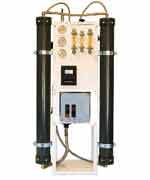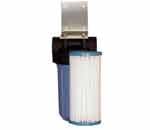There are many factors that may cause cloudy or turbid water. Cloudy water can also be referred to as having high levels of turbidity. The most common causes of turbidity are organic matter, and/or colloidal solids that are too small and too fine to settle out properly. These suspended particles can cause problems with disinfection processes, and also be an indicator of bacterial activity in the water. Turbidity is measured in NTU's, (nephelometric turbidity units). The turbidity of drinking water should always be less than 1 NTU. Most treated city water is less than .2 NTUs.
While it is possible to filter water containing colloidal particles, and/or water that has a color to it, generally filtration is the last step in a process of treating this type of water. To remove turbidity, often the first step is to inject a flocculant, or coagulant aid, which allows these microscopic suspended particles to lose their positive charge and “floc” together into larger clumps. This is easily done on small scale systems by using a metering pump and injecting 2 -5 ppm of “Cat-Floc” (one of the many types of flocculant aids used for this purpose) into the water as it flows into a holding tank or storage tank. The water is allowed to settle, and is then followed by filtration to remove any suspended floc. In some cases the water must be gently stirred or agitated in order for the floc to form.
A very effective method to remove turbidity is with reverse osmosis (“RO”) or ultrafiltration (“UF”) membrane systems. RO and UF systems can be used by homeowners, small communities and commercial sites to reduce turbidity and produce crystal clear water less than 0.1 NTUs.
In addition to RO and UF membrane systems, direct filtration can be used. Depending on the nature of the turbidity, a backwashing sediment filter using a special type of zeolite filter media does a great job at clarifying water. Sediment down to the 5 to 10 micron range can be removed, and then backwashed out periodically by the automatic control valve.
Another low cost option is to use a whole house cartridge filter. These filters are large size filter cartridge systems which come in various micron ratings and can filter down to the 1 micron size. One option frequently used by homeowners with cloudy water is to use a backwashing sediment filter, followed by a 1 or 5 micron fitler cartridge system.
There are many different designs and application criteria that must be considered, including the water chemistry, flow rates, how the water will be disinfected and what types of filtration to use. In some cases additional treatment such as reverse osmosis or other membrane filtration systems are used in conjunction with the polymer injection and settling.
Need help selecting a system? Fill out our quick and easy Water System Designer Form and get a response in 24 hours or less.









